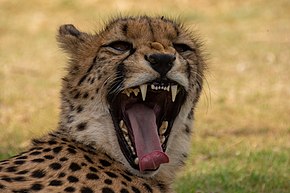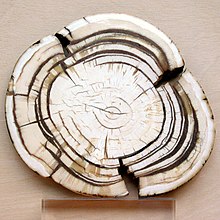Mammal tooth

Teeth are common to most vertebrates, but mammalian teeth are distinctive in having a variety of shapes and functions. This feature first arose among the Therapsida (mammal-like reptiles) during the Permian, and has continued to the present day. All Therapsid groups with the exception of the mammals are now extinct, but each of these groups possessed different tooth patterns, which aids with the classification of fossils.
Mammal teeth include incisors, canines, premolars, and molars, not all of which are present in all mammals. Various evolutionary modifications have occurred, such as the lack of canines in Glires, the development of tusks from either incisors (elephants) or canines (pigs and walruses), the adaptation of molars into flesh-shearing carnassials in Carnivora, and others.
Diversity
The extant mammalian infraclasses each have a set dental formula; the Eutheria (placental mammals) commonly have three pairs of molars and four premolars per jaw, whereas the Metatheria (marsupials) generally have four pairs of molars and between three or two premolars. For example, the tiger quoll (Dasyurus maculatus) is a dasyurid marsupial native to Australia. The quoll possesses four upper incisors and three lower incisors per left and right-hand side [I = 14]; two upper premolars [PM] and two lower premolars per side [PM = 8]; and four upper and four lower molars per side [M = 16], giving the animal a complement of thirty-eight teeth. The tiger quoll's dental formula is as follows: 4.1.2-3.43.1.2-3.4.
Rabbits
Rabbits and other lagomorphs usually shed their deciduous teeth before (or very shortly after) their birth, and are usually born with their permanent teeth.[1] The teeth of rabbits complement their diet, which consist of a wide range of vegetation. Since many of the foods are abrasive enough to cause attrition, rabbit teeth grow continuously throughout life.[2] Rabbits have a total of 6 incisors (two upper and one lower on either side), three upper premolars on each side of the maxillary bone (total of six), three upper molars on each side, two lower premolars on each side of the jaw, and two lower molars on each side of the jaw. There are no canines. Three to four millimeters of tooth is worn away by incisors every week, whereas the posterior teeth require a month to wear away the same amount.[3]
Anatomy of rabbit teeth
The incisors and cheek teeth of rabbits are called aradicular hypsodont teeth. Aradicular teeth never form a true root with an apex, and hypsodont teeth have a high crown to root ratio (providing more room for wear and tear).[4] This is sometimes referred to as an elodont dentition, meaning ever-growing. These teeth grow or erupt continuously. The growth or eruption is held in balance by dental abrasion from chewing a diet high in fiber.
Rodents
Like those of rabbits, rodents' incisors grow continuously throughout their lives, and are both aradicular and hypsodont. Unlike humans whose ameloblasts die after tooth development, rodents continually produce enamel and must wear down their teeth by gnawing on various materials.[5] These teeth are used for cutting wood, biting through the skin of fruit, or for defense. The teeth have enamel on the outside and exposed dentin on the inside, so they self-sharpen during gnawing. On the other hand, continually growing molars are found in some rodent species, such as the sibling vole and the guinea pig.[6][7] There is variation in the dentition of the rodents, but generally, rodents lack canines and premolars, and have a space between their incisors and molars, called the diastema region.
Humans
Afrotherians
Elephants

Elephants' tusks are specialized incisors for digging food up and fighting. Elephants are polyphyodonts with teeth are similar to those in manatees, and it is notable that elephants are believed to have undergone an aquatic phase in their evolution.
Elephants have four molars, one on each side of the upper and lower jaw. Until age 40, these are replaced by larger molars. The new molars shift forward from the back of the jaw as the old wear down. The final set of molars last for about twenty years.[8]
Manatees
Manatees are polyphyodonts with mandibular molars developing separately from the jaw and are encased in a bony shell separated by soft tissue.
Aardvarks
In Aardvarks, teeth lack enamel and have many pulp tubules, hence the name of the order Tubulidentata.
Ungulates
Horses
An adult horse has between 36 and 44 teeth. All horses have twelve premolars, twelve molars, and twelve incisors.[9] Generally, all male equines also have four canine teeth (called tushes) between the molars and incisors. However, few female horses (less than 28%) have canines, and those that do usually have only one or two, which many times are only partially erupted.[10] A few horses have one to four wolf teeth, which are vestigial premolars, with most of those having only one or two. They are equally common in male and female horses and much more likely to be on the upper jaw. If present these can cause problems as they can interfere with the horse's bit contact. Therefore, wolf teeth are commonly removed.[9]
Horse teeth can be used to estimate the animal's age. Between birth and five years, age can be closely estimated by observing the eruption pattern on milk teeth and then permanent teeth. By age five, all permanent teeth have usually erupted. The horse is then said to have a "full" mouth. After the age of five, age can only be conjectured by study of the wear patterns on the incisors, shape, the angle at which the incisors meet, and other factors. The wear of teeth may also be affected by diet, natural abnormalities, and cribbing. Two horses of the same age may have different wear patterns.
A horse's incisors, premolars, and molars, once fully developed, continue to erupt as the grinding surface is worn down through chewing. A young adult horse will have teeth which are 4.5-5 inches long, with the majority of the crown remaining below the gumline in the dental socket. The rest of the tooth will slowly emerge from the jaw, erupting about 1/8" each year, as the horse ages. When the animal reaches old age, the crowns of the teeth are very short and the teeth are often lost altogether. Very old horses, if lacking molars, may need to have their fodder ground up and soaked in water to create a soft mush for them to eat in order to obtain adequate nutrition.
Pigs
Tusks, which grow larger in males and in wild boars, are derived from the canine teeth, a trait shared with warthogs.
Cetaceans
The toothed whales, comprising the Odontoceti suborder of the cetaceans, are differentiated from the baleen whales by the presence of their teeth. The number of teeth and their function can vary widely between species, with some dolphins having over a hundred teeth in their jaws, while the Narwhal has two functional teeth in its upper jaw which grow into long tusks in males. The tusk is used in feeding, navigation and mating and contains millions of sensory pathways, making it the most neurologically complex tooth known. In contrast, the Sperm whale has up to forty teeth in its bottom jaw and none functional in its upper.
Carnivorans
In the order Carnivora, either the molars, or the premolars and molars in combination, may be adapted into shearing carnassials.
Walrus
Walrus tusks are canine teeth that grow continuously throughout life.[11]
Dogs
In dogs, the teeth are less likely than humans to form dental cavities because of the very high pH of dog saliva, which prevents enamel from demineralizing.[12]
References
- ^ Dental Anatomy & Care for Rabbits and Rodents
- ^ Brown, Susan. Rabbit Dental Diseases Archived 2007-10-14 at the Wayback Machine, hosted on the San Diego Chapter of the House Rabbit Society. Page accessed April 9, 2007.
- ^ Ryšavy, Robin. The Missouri House Rabbit Society, hosted by the Kansas City Missouri House Rabbit Society. Page accessed April 9, 2007.
- ^ Verhaert, with Leen (2013-01-01), Gorrel, Cecilia; Andersson, Susanne; Verhaert, Leen (eds.), "Chapter 14 - Dental diseases in lagomorphs and rodents", Veterinary Dentistry for the General Practitioner (Second Edition), W.B. Saunders, pp. 191–211, ISBN 978-0-7020-4943-9, retrieved 2020-03-05
- ^ Caceci, Thomas. Veterinary Histology with subtitle "Digestive System: Oral Cavity" found here Archived 2006-04-30 at the Wayback Machine.
- ^ Tummers M and Thesleff I. Root or crown: a developmental choice orchestrated by the differential regulation of the epithelial stem cell niche in the tooth of two rodent species. Development (2003). 130(6):1049-57.
- ^ AM Hunt. A description of the molar teeth and investing tissues of normal guinea pigs. J Dent Res. (1959) 38(2):216-31.
- ^ Bram, L. et al. MCMLXXXIII. Elephants. Funk & Wagnalls New Encyclopedia, Volume 9, p. 183. ISBN 0-8343-0051-6
- ^ a b Patricia Pence (2002), Equine Dentistry: A Practical Guide, Baltimore: Lippincott Williams & Wilkins, ISBN 0-683-30403-8
- ^ Al Cirelli, Equine Dentition (PDF), Nevada: University of Nevada, retrieved 7 June 2010
- ^ The Permanent Canine Teeth, hosted on the University of Illinois at Chicago website. Page accessed February 5, 2007.
- ^ Chris C. Pinney, The Illustrated Veterinary Guide for Dogs, Cats, Birds, and Exotic Pets (Blue Ridge Summit, PA: TAB Books, 1992), p. 187.
External links
- Beach, Chandler B., ed. (1914). . . Chicago: F. E. Compton and Co.
